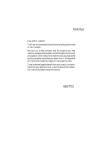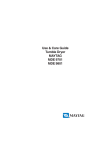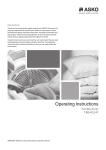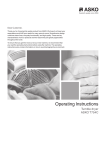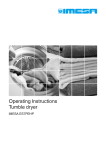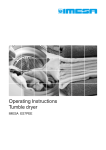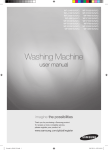Download Maytag MDE9901 Use & care guide
Transcript
Use & Care Guide Tumble Dryer MAYTAG MDE 9901 CONTENTS READ FIRST Page 1 Before tumble drying for the first time 3 2 Safety instructions 4 General, Installation, Safety, Interrupting a programme, Transport/Winter storage, Packing materials, Disposal 3 Child safety 7 5 Panel 8 6 LC display 8 INSTALLATION See Installation Instructions TUMBLE DRYING 12-15 Tumble drying, Instructions – step-by-step, Automatic draining 9 Consumption values – pre-set drying 16 10 Making your own drying programmes 1 7 - 2 1 General, Available settings and options, Available programmes, Create your own drying programme, Interrupt input, Reset programme, Menu system for altering preset programmes 2 Cleaning the lint filter, Draining the condensation water container, Cleaning the outside of the dryer, Cleaning the fan, Cleaning the condenser 12 Trouble shooting 26-28 Dryer will not start, Overheating protection, No interior lighting, Drying takes too long, Fault messages, Wrong language on the display, Stop flashes in the display, Reset programme MISCELLANEOUS 9-11 Spin-dried?, Washing instructions, Sorting fabrics, Programmes, Options, Temperature, Drying time programmes 23-25 PROBLEMS? 4 Parts of the tumble dryer 8 Tumble dry Page 11 Care and cleaning 5 General, Child lock 7 Before tumble drying CARE 13 Technical information 29 Technical data, Standard tests 14 Service and guarantee 30 15 Index 31 16 Quick guide 32 1 BEFORE TUMBLE DRYING THE FIRST TIME READ THE OPERATING INSTRUCTIONS NOTE Please read through this Use and Care Guide before attempting to use the machine, particularly Chapter 2, Safety instructions, and 3, Children’s safety. When you start the tumble dryer the first time, or after a long period when it has not been in use, you may hear a light rumbling noise. This is quite normal and the sound will disappear after a few drying operations. DO NOT TUMBLE-DRY Some fabrics are sensitive to tumble drying. Check the Recommended washing marking on the items concerned, and study Chapter 7, Before tumble drying. For brief operating instructions; see Chapter 16, Quick guide. 3 2 SAFETY INSTRUCTIONS GENERAL sing the main switch, • Study and save this Use and Care Guide for future reference. • Electrical installation, if required, must be carried out by an authorized electrician. • The machine may only be used for tumble drying in accordance with this Use and Care Guide. • Repairs and maintenance which affect safety or performance must be carried out by an authorized specialist. • Damaged mains cables must only be replaced by an authorised professional. • Sufficient ventilation is required to prevent smoke from open fires or fumes from equipment burning other fuels being sucked into the room. door causing the drum to stop automatically. The machine will “remember” where in the programme it was when stopped. If you wish to continue the drying process, just close the door INSTALLATION See the accompanying installation instructions. SAFETY This machine may not be used for drying fabrics that have been dry-cleaned at home, or which can be suspected of containing residues of flammable fluids. The tumble dryer is fitted with an overheating protection device, which switches the machine off in the event of excessive temperature. A float valve switches the machine off if the condensation water hose becomes clogged, or if there is danger of water flowing over from the container. INTERRUPTING THE PROGRAMME A drying programme can be interrupted by pres- 4 and press the , or by opening the -button and the machine will start where it was interrupted. You can also interrupt a programme by pressing for three seconds. However, if you stop the machine in this way it will forget where it was in the programme and you will have to select a programme to restart. TRANSPORT/WINTER STORAGE If the machine is to be transported or stored during the winter, on unheated premises, ensure that the water container is drained. PACKING MATERIAL Sort the packing material for recycling according to recommendations by the local authorities. DISPOSAL When the machine is no longer useful and is to be scrapped it should be made unusable. Get in touch with the refuse collection service or your local authorities for advice on how to scrap the machine in a proper manner. The machine is made and marked to facilitate recycling. CAUTION! During the programme, the back of the tumble dryer will get very hot. Leave the machine to cool completely before touching the back. 3 CHILDREN’S SAFETY GENERAL To start a programme with locked Do not allow children to play with the tumble dryer. The tumble dryer is fitted with a magnetic catch, which allows the door to be opened from the inside. The door is equipped with a switch, which automatically stops the tumble dryer when the door is opened. The machine will not start automatically on closing the door (eg, if a child should close the door from the inside). button. CHILD LOCK ON By locking the AND and Menu Menu Press the button for three seconds and the machine will start. To change programme settings with Child locked Menu Press the button. Menu button for three seconds, after that the Menu button works normally again. If you do not press any button within two minutes, the Menu button will be locked again. BUTTONS buttons, you can prevent that for example a child starts the machine or changes the settings by mistake. Child lock On/Off Turn the main power switch, turn it on again. Press the the P3 Enter , off and then button five times, then press button five times. These ten times must be completed within fifteen seconds. Within three seconds after the last press on the P3 button, use the buttons to choose Child lock ON (the figure 3 will appear at the bottom right in the display) or OFF (the figure 0 will appear at the bottom right in the display). 5 This page has been left blank for technical printing reasons. 6 4 PARTS OF THE TUMBLE DRYER 3 4 2 1 9 6 5 7 8 1. FLUFF-FILTER HOLDER 6. INTERIOR LIGHTING (ON THE INSIDE) 2. DATA PLATE 7. FAN (BEHIND THE LOWER COVER) 3. CONDENSATION WATER CONTAINER 8. CONDENSER (BEHIND THE LOWER 4. PANEL 5. OUTER DOOR COVER) 9. LINT FILTER 7 5 PANEL 2 1 4 3 !$!-!3#/.$%.3%2#534/-4/5#( 5 6 7 8 9 10 1. INDICATOR LAMP ON/OFF 6. STOP BUTTON 2. MAIN POWER SWITCH 7. MENU BUTTON 3. PROGRAMME SELECTOR BUTTONS P4-P4 8. INDEX BACK/REDUCE TIME 4. DISPLAY 9. INDEX FORWARD/INCREASE TIME 5. START BUTTON 10. ENTER BUTTON 6. LC-DISPLAY 1 2 3 NOTE 9 8 The display will be extinguished if no buttons are pressed within three minutes. The display will be reinstated the next time any button is pressed. 5. INDICATES THAT A PROGRAMME HAS 4 5 6 7 STARTED 6. INDICATES THAT A PROGRAMME HAS BEEN COMPLETED 1. TEXT FIELD INDICATING PROGRAMME, OPTIONS AND FAULT MESSAGES, ETC. 2. INDICATES THAT 3 IS SHOWING THE SELECTED TIME FOR A TIMED DRY OR AN AIR FLUFF PROGRAMME 3. SHOWS THE SELECTED TIME FOR TIMED DRY PROGRAMMES 4. INDICATES THE SELECTED PROGRAMME 8 7. SEE 8 AND 9 BELOW 8. INDICATES THAT DELAYED START IS ON. 7 THEN INDICATES HOURS REMAINING TO START 9. INDICATES THAT 7 IS DISPLAYING THE PROGRAMME TIME REMAINING IN HOURS AND MINUTES (ALTERNATING), INCLUDING THE COOLING TIME. 7 BEFORE TUMBLE DRYING Before you start tumble drying, here is some advice that can be useful. SPIN-DRIED? Items that are to be tumble dried should first be spin-dried, preferably at 800 revs per minute or more. Better spin drying saves both energy and drying time. RECOMMENDED WASHING MARKING Material suitable for tumble drying The symbol above indicates that the material can be tumble-dried. Cotton fabrics, towelling and synthetic fibres are best suited to tumble drying. Clothes and fabrics become softer and fluffier when tumble-dried than when dried on a line. NOTE Wear and tear of fabrics in a tumble dryer is minimal. The lint caught in the lint filter consists of dust and fibre residue that has been formed when wearing the garments. Material which should not be tumbledried This symbol indicates that the material will not withstand tumble-drying. Certain materials will melt or become dangerously flammable if heated, while others will loose their shape or shrink. Do not tumble-dry... • Materials that are marked “Do not dry close to heat”. • Items that have been dry-cleaned at home. • Foam plastic. • Glass-fibre materials • Woollen items, because of the risk of felting. SORTING FABRICS Best results are obtained if all articles are of the same material. Close zip-fasteners, button up garments, tie belts, and sort the fabrics and adapt the load and the temperature as shown in the table below. TYPE OF FABFIC LOAD White, coloured Cotton and and synthetic linen 1/1 (6.0 kg) Normal 1/2 (3.0 kg) Normal Polyester/ cotton Delicate and mild Acrylic, rayon, 1/2 (3.0 kg) acetate etc. TEMPERATURE Low Sort a suitable amount and type of fabric. 9 PROGRAMMES Your choice of programme will depend on what you wish to do with the fabrics after tumble drying. The available programmes are Extra dry, Dry, Normal dry, Iron dry, Timed dry and Air fluff. Extra dry This programme is designed for washing that is extremely difficult to dry, eg, jeans with very thick seams. NOTE Knitted fabrics in particular are liable to shrink. Use the Dry, Normal dry or Iron dry programme for these materials. Always stretch garments out directly after drying. When using a timed dry programme with mixed washing it may happen that some of the items will not be sufficiently dried. Such items can suitably by dried by running the timed programme for a further 10 minutes or so. Timed dry programmes automatically operates at temperature Low, but you can change it yourself to Normal. NOTE When using a timed programme it is possible to over-dry fabrics if you set too long a time. This can cause fabrics to shrink or crease and feel rough. Synthetic materials can also become charged with static electricity. Set a shorter time if you tumble dry at temperature Normal. Air fluff Dry, Normal dry These programmes turn off the heat when the washing is dry, but not bone-dry. The Dry programme turns off the heat a little later than Normal dry. Choose what you prefer by trial and error. Use these programmes when you want dry fabrics. Use the air fluff programme just to shake dust out of garments, air them or soften them up. To select Timed dry or Air fluff , see Chapter 10, Making own drying programmes. OPTIONS Cooling Iron dry This programme turns off the heat when the washing is just damp enough for ironing or mangling. You can choose between Normal cooling and Quick cooling. Normal cooling lasts 20 minutes and Quick cooling lasts 5 minutes. Buzzer Timed dry The programme length that you should choose depends on what you wish to do with the fabrics after tumble drying. Dry different times for different materials to find the right combination. 10 The machine offers you the possibility of hearing when the cooling period ends. Set the option Buzzer ON and it will sound for three seconds when the programme is completed. Anti-crease programme DRYING TIME Using the Anti-crease programme you can prevent garments from lying still and becoming unnecessarily creased at the end of tumble drying. This is a helpful option if you cannot take out garments promptly at the end of the tumbling phase. You can choose a programme duration of 1, 2 or 3 hours. The drum will then continue to rotate intermittently, ie, three seconds every minute for the number of hours chosen. If you choose Buzzer ON, a signal will sound each time the drum rotates. The drying time may be influenced by a number of factors, such as the size of the load, the program selected, the moisture content of the load, the materials being washed, connection capacity and the ambient temperature and humidity. Drying time remaining is calculated within four minutes of the start of the drying program. The estimated time is shown in the bottom righthand corner of the display, together with the – symbol. If the actual drying time is less than that calculated, the time display may jump ahead, e.g. from 50 to 20 minutes, at the end of the program. If the actual drying time is longer than that calculated, the countdown will stop at the end of the progam until the load is dry. Please note that times include a cooling period. To choose these options, see Chapter 10, Making own drying programmes. TEMPERATURE You can choose temperature Normal or Low, see chapter 10, Making own drying programmes. 11 8 TUMBLE DRY 1 For tips and advice, see Chapter 8 – Before tumble drying. TUMBLE DRYING WITH EASY CONTROL Easy tumble drying by pushing a few buttons Your tumble dryer works like a radio with preset tuning. Instead of radio stations, however, you select your preferred drying programme in this case. We have preset the P1 - P4 buttons with four common programmes. Switch on the dryer and press the button for your preferred programme. You then simply press the Start button to start the programme. NOTE Empty the pockets. Coins, nails and similar items can cause damage to the dryer. 2 3 4 TURN ON THE MAIN POWER SWITCH OPEN THE DOOR, PUT IN THE WASHING To alter the settings for P1 - AND CLOSE THE DOOR AGAIN P4 You can create your own favourite programmes, if you wish. You can even preset Timed dry and Air fluff programmes. You can also adapt settings and options such as temperature, buzzer, cooling and delayed start to suit your particular needs. Chapter 10 - Making your own drying programmes, tells you what to do to create a temporary or permanent drying programme. It also includes a description of all the available programme types, options and other settings. SORT FABRICS See Chapter 7 for the recommended quantity of washing – Before tumble dry- ing. SELECT A PROGRAMME [##] The dryer has four pre-set programmes. Press the button for the desired programme. The programmes are shown in the table below. Your choice of programme will depend on what you wish to do with the fabrics after tumble drying. See also Chapter 7 – Before tumble drying. 12 DE LAY ED STA RT TEM PER ATU RE OP An TIO tiNS pro creas gra e mm e Buz zer g olin Co PR OG RA MM E PR OG RA MM EB UT TO N SETTINGS OF THE FOUR PRE-SET PROGRAMMES. P1 EXTRA DRY NORMAL ON ON, 1 h NORMAL 0h P2 DRY NORMAL ON ON, 1 h NORMAL 0h P3 NORMAL DRY NORMAL ON ON, 1 h NORMAL 0h P4 IRON DRY NORMAL ON ON, 1 h NORMAL 0h 5 START TUMBLE DRYING Press the button. The text at the lower edge of the display indicates that the programme has started. The text field of the display shows the current stage of the programme while it is in progress. NOTE If the child lock is on, the button must be held down for 3 seconds in order for the programme to start. See Chapter 3, Child safety, for details of how to switch the child lock on and off. Remaining drying time The approximate remaining drying time is estimated within four minutes of the start of the drying programme. Only the time for the Timed dry programme and Air fluff programme is indicated for venting dryers. The time is shown in hours and minutes (alternating) at the bottom right of the display together with the symbol. Note that the time also includes cooling. 6 DRYING PROGRAMME ENDED The text on the bottom edge of the display indicates that the programme has ended. If the Anti-crease option is activated, the drum will rotate every minute for a certain period after cooling. The text [“Anti-crease”] is indicated in the display during this period. The programme can be stopped at any time by opening the door. When the programme ends: • Clean the lint filter after each drying operation, see below. An error message will be displayed if the lint filter needs to be cleaned. • Empty the condensation water container. WARNING! If the lint filter becomes completely clogged the overheat protection device may trigger. The device must then be reset to enable the machine to be started, see Chapter 12, Trouble shooting. DURING TUMBLE DRYING Putting in more washing Open the door and the drum will stop automatically. To restart: Close the door and press the button. Changing programme Press the button for three seconds. The programme will then be zero set and you can choose a new programme. 13 CLEANING THE LINT FILTER 1. Grasp the filter handle and pull towards you. terrupted, see also Chapter 12, Trouble shooting, heading Fault indications. NOTE 2. Pull the filter up out of the holder. Do not pull out the condensation water container while the machine is running. 3. Open the filter and brush away the lint with your hand. HINT 4. Fold the filter together and put it back in the filter holder. The condensation water is soft, and is therefore suitable for use in a steam iron. Strain the water through a coffee paper filter before use. If you want the water to be emptied automatically, see the Installation instructions. 2 The filter may require cleaning if lime scale deposits are present; see Chapter 10, Care and Cleaning. 1 7 AFTER TUMBLE DRYING Turn off the main switch . AUTOMATIC DRAINING EMPTYING THE CONDENSATION WATER CONTAI- See the Installation Instructions if you require the water to be drained automatically. NER Empty the condensation water container after each tumble drying. Pull out the condensation water container, empty the water and put the container back. If the container becomes too full, the programme will be interrupted and an error message will be displayed in the text field. Empty the container and press the button and the programme will continue from where it was in- 14 TEMPORARY PROGRAMME If you wish to run a programme without altering the pre-set programmes P1 - P4 , you can create a temporary programme; see Chapter 10 - Making your own drying programmes. DELAYED START (1-24 HOURS) If Delayed start is set to 5 hours, for example, this means that the machine will start the programme 5 hours after you press the button. If you wish to delay the start of any programme temporarily, you should proceed as follows before pressing the button: 1. Select the programme, but do not press the button. 2. Index forward with the Menu button until Delayed start appears in the display. 3. Index forward to the desired number of hours with . 4. Press the Enter button once. The selected programme appears in the display. 5. Press to start the programme. Delayed start is disconnected automatically at the end of the programme. 15 9 CONSUMPTION VALUES - PRE-SET DRYING PROGRAMMES The following conditions apply for the consumption values indicated below: Temperature of intake air:20 ºC. Humidity of intake air: 65 %. Drying temperature: Normal ( ), Low ( ). Element power: 2500 W. The cotton fabrics are, before tumble drying, spin-dried at 800 and 1600 rpm (long spin) with MAYTAG washing machine. Other fabrics (creasfree and acrylics) are, before tumble drying, spin-dried at 800 rpm (short spin) with MAYTAG washing machine. PROGRAMME WASHING AMOUNT OF ENERGY CONSUMPTION WASHING ( ca kWh) 800 rpm - P1 PROGRAMME TIME (ca minutes) 1600 rpm 800 rpm - 1600 rpm Cotton, linen, 1/1 (6.0 kg) 4.5 - 3.7 115 - 95 P2 Cotton, linen, 1/1 (6.0 kg) 4.0 - 3.2 100 - 80 Dry Crease free, poly- 1/2 (3.0kg) 1.8 --- 45 Cotton, linen, 1/1 (6.0 kg) 3.8 2.9 90 Crease free, poly- 1/2 (3.0kg) 1.6 --- 450 -- 1/2 (3.0 kg) 2.1 --- 75 --- 1/1 (6.0 kg) 3.0 2.0 80 Extra dry --- ester/cotton, P3 Normal dry - - 70 ester/cotton, Acrylics, rayon, acetate, P4 Iron dry 16 Cotton, linen, - - 505 10 MAKING OWN DRYING PROGRAMMES We have preset P1 - P4 with the most common drying programmes; see the table below. These programmes usually suit most users. You can also create your own programmes to suit you and your washing needs even better. You can select a different type of programme, for example a Timed dry programme and an Air fluff programme, or you can alter settings and options such as Buzzer, Temperature, Non-iron, Cooling or Delayed start. This Chapter includes tables containing information about all programme types, settings and options. Change programme In this Chapter we tell you how to replace one or other of the pre-set programmes with a programme of your own. By storing the programme, it will then be accessible simply by pressing a button every time you wish to use the tumble dryer. Temporary programme You can also make a temporary change of programmes, settings and options. The change is not stored in this case, but is deleted as soon as the programme is completed and the door is opened. OP An TIO tiNS pro rease gra mm e TEM PER ATU RE ON ON, 1 h NORMAL 0h NORMAL ON ON, 1 h NORMAL 0h P3 NORMAL DRY NORMAL ON ON, 1 h NORMAL 0h P4 IRON DRY NORMAL ON ON, 1 h NORMAL 0h olin DE LAY ED STA RT Buz zer NORMAL DRY g EXTRA DRY PR OG RA MM E P1 P2 PR OG RA BU MM TTO E N Co SETTINGS OF THE FOUR PRE-SET PROGRAMMES. 17 AVAILABLE SETTINGS AND OPTIONS Setting/Option Description Programme types Available programmes are described in a separate table. Change of programme type resets all options and settings to their original values. Temperature, low/normal Drying temperature. All programmes without Air fluffing. Delayed start (0-24 hours) If you select a delayed start of five hours, for example, the machine will start five hours after you pressed the start button. The time remaining until the start is shown in the display. The change to this option is not stored permanently. Can be used with all programmes. Buzzer On/Off With Buzzer On, a 3-second buzzer signal will be heard at the end of the programme. Can be used with all programmes. Crease-free 0-3 hours (0-180 min) The drum will rotate for 3 seconds per minute for the indicated period after the end of the drying programme. With Buzzer On, a buzzer signal will be heard each time the drum rotates. Can be interrupted at any time by opening the door. Can be used with all programmes. Cooling, Normal/Short Normal cooling continues for 20 minutes, and short cooling for 5 minutes.. All programmes without Air fluffing. AVAILABLE PROGRAMME TYPES 18 Restrictions Programme type Description Extra dry Programme that gives the driest fabrics. Dry Shuts off the heat when the fabrics are dry, but without being snuff-dry. Dry shuts off a little later than Normal dry. Normal dry Shuts off the heat when the fabrics are dry, but without being snuff-dry. Iron dry Shuts off the heat when the fabrics are still slightly damp. Timed dry You decide the duration of the programme by using an individual setting as described below. You can also change the duration with the buttons on each occasion before you use the programme (before you press . Air fluff A programme without drying heat, under which you select the duration of the programme (see Timed dry programme). CREATE YOUR OWN DRYING PROGRAMME 1. Press one of the buttons P1 - P4 under which you wish to store your programme. You can select any button you like if you only want to make a temporary programme. 2. Index forward with the Menu button to the first setting or option that you wish to change. If the child lock is activated, nothing will happen. Hold down the button for 3 seconds, and then press as usual. All the programme types, settings and options are described in the table alongside. Select Program Extra dry < Next You can now use the programme without storing it (temporary programme). Press the button to start the programme. Store the programme If you wish to store the programme for use whenever you intend to use the tumble dryer, press the Enter button before starting. The button selected by you originally (P1-P4) will appear at the bottom left of the display. You can now select the programme by pressing the button chosen by you in Step 1. NOTE > The Delayed start option is not stored permanently. x change a setting, you should 3. If you wish to index forward or back with the buttons until the desired setting appears in the display. Select Program Timed dry progr. < Next > IMPORTANT If you store a programme by mistake, you can reset it to its settings at the time of delivery; see Reset programme later in this Chapter. TIP x 4. Then index further with the Menu button to the next setting/option, and change it in the same way if required. 5. Index further and make changes in the same way until the finished programme appears in the display together with any options. The text Stop will be displayed on the bottom line. Timed dry r Normal cooling Temperature low Stop Time 60 If you do not wish to index through all the settings, you can terminate the input by pressing the Enter button ONCE. To store the programme, you must then press the Enter button once more. INTERRUPT INPUT If you change your mind and wish to interrupt the input sequence, you should switch off the dryer with the main power switch . When you switch it on again, you can start from the beginning or select one of the pre-set programmes as usual. x 19 RESET PROGRAMME If you wish to revert to the settings which a preset programme had at the time when the dryer was supplied, you can reset the programme. Proceed as follows: 1. Hold down the programme button (P1-P4) for the programme that you wish to reset. 2. Press the Enter button once. 3. Release the programme button. The programme for the button concerned will now have reverted to its settings at the time when the dryer was supplied. 20 MENU SYSTEM FOR CHANGING A PRESET PROGRAM Select Program Select program to be changed Menu Change with: Enter Menu P1 - P4 (For a temporary change, select any button). Select Time Change with: Enter Menu Select Temperature Change with: Index to next Enter Menu Select Delayed start Exit from menu/ Save program Select setting Change with: Enter Menu NOTE Not all steps are shown for all program types. Only permitted settings are shown in the display. Select Buzzer Change with: Enter Menu You can change several settings/options consecutively. Simply index forwards with Menu Then finish by continuing until the program is Select Anti-crease shown in the display, or press Enter Change with: Enter Menu Select Cooling Change with: Menu Enter Program changed and shown in the display, but not stored in the memory. The program can now be started with Start The program will disappear the next time P1 - P4 is pressed or when the machine is switched off. Enter The new program is stored in the memory. The program can now be started with Start The program can be used each time you want to dry 21 This page has been left blank for technical printing reasons. 22 11 CARE AND CLEANING CLEANING THE LINT FILTER EMPTYING THE CONDENSATION WATER CONTAI- Clean the lint filter after each tumble drying operation. If your water is very hard a deposit of lime may be formed on the filter. Check when cleaning lint from the filter if there is any sign of lime, if so wash the lint filter by hand to remove any deposits. NER Empty the condensation water container after each tumble drying. Pull out the condensation water container, empty the water and put the container back. 1. Grasp the filter handle and pull towards you. 2. Pull the filter up out of the holder. If the container becomes too full, the programme will be interrupted and an error message will be displayed in the text field. Empty the container and press the 2 1 button and the programme will continue from where it was interrupted, see also Chapter 12, Trouble shooting, heading Error messages. NOTE Do not pull out the condensation water container while the machine is running. CLEANING THE OUTSIDE OF THE MACHINE 3. Open the filter and remove fluff from all sides of the filter by hand. Use a soft dry cloth to remove any remaining fluff. 4. Replace the filter in the filter holder. If limescale develops on the filter, rinse it in water to remove the limescale. Dry the filter thoroughly with a hand towel. Use a mild detergent to clean the outside of the machine. Do not use any solvents, they can damage the machine. Do not spray the machine with water. NOTE Do not allow dust to accumulate round the machine. Keep clean and cool around the tumble dryer. Dust, heat and moisture prolong the drying time. 23 CLEANING THE FAN The fan should be cleaned at least once a year. If you have any household pets the fan must be cleaned more often. 5. Take out the fan and clean it with a brush and water. 1. Turn off the main power switch. 2. Remove the lower cover. 6. Put the fan back into place and screw on the nut. 3. Remove the safety screw (1). Prise out the four clips in the order shown and remove the fan cover. 2 3 4 5 7. Refit the fan cover, making sure the clips hold the cover in place. Don’t forget to fit the safety screw. 1 4. Unscrew the nut while holding the fan. 8. Fit the lower cover back in place. 22 2 1 24 CLEANING THE CONDENSER The condenser should be cleaned at least three times a year. . If you have any household pets the condenser must be cleaned more often. 1. Turn off the main power switch. 5. Refit the condenser, taking care to fit it the right way up. The top of the condenser is marked “upp”, “up” and “oben”. UPP UP OBEN 2. Remove the lower cover. 6. Fit the lower cover back in place. 3. Turn the two levers anticlockwise to open the condenser cover. 22 2 1 4. Take the condenser out and rinse the condenser fins clean, eg, using a hand-held shower. Do not poke anything between the fins, you might damage the condenser. Do not use any sharp object when cleaning the fins. NOTE Do not attempt to clean the condenser in a dishwasher. 25 12 TROUBLE SHOOTING THE MACHINE WILL NOT START Check that: • The door is properly closed. • The main switch is pressed in. • You have correctly set the required programme or the required time in the timed dry programme. • You have not choosen Delayed start. • The electric plug, if any, is firmly inserted in its socket. • All fuses are intact. Switch two fuses over. It is not always possible to see directly if a fuse has blown. • The overheating device has not triggered, see below. OVERHEATING PROTECTION The dryer is designed with an overheat protection switch that will automatically turn the machine off if the temperature gets too high. The machine will not start until it has cooled down sufficiently. If the unit shuts down because of overheating, check that the lint filter exhaust hose, vent duct, and the condenser unit are free of lint. These components need to be cleaned on a regular basis. Additionally, the lint filter may need to be cleaned with warm, soapy water and a soft brush a few times a year to ensure the filter screen is not blocked. Using dryer sheets (not recommended) can also cause this problem. Should the machine turn itself off because of overheating, it will not be possible to restart the unit until it has cooled down sufficiently. This could possibly take up to thirty minutes. 26 To restart the unit once it has cooled down, press the ”Start” button. NOTE: If your dryer overheats frequently, it may not be vented properly or the room in which it is located may not have sufficient air circulation. Contact your installer to have these issues checked out. NO INTERIOR LIGHTING Check that: • The main switch is pressed in. • The electric plug, if any, is firmly inserted in its socket. • All fuses are intact. Switch two fuses over. It is not always possible to see directly if a fuse has blown. • The bulb is not burnt out. The lamp is located at the top of the dryer just inside the door. Screw off the plastic cover protecting the bulb and screw out the bulb and replace it if it is faulty. EXCESSIVE DRYING TIME Empty the water container and check that the lint filter and the condenser are not clogged, see Chapter 11, Care and Cleaning. Excessive drying times can also be caused by the machine being installed in a very confined space and by the air in the room (which cools the machine) becoming too warm. In this situation make sure that ventilation is improved, eg, by opening doors and/or windows. FAULT INDICATIONS WRONG LANGUAGE ON THE DISPLAY Error messages appear in the display text field if faults occur while a programme is in progress. To exit the error messages after correcting the fault as described below, switch the machine off or change the programme. The error messages that can be displayed are: If the language on the display becomes altered for any reason, it can be restored to the initial language again. The available languages are Eng (AUS), Svenska, Dansk, Norsk, Suomi, Francais, Nederlands, Italiano, Espanol, Russia, Deutsch, Eng (US). Proceed as follows to change the language: Maximum programme time. When the machine has run for its maximum time (three hours) it will stop. Ensure first that all fuses for the machine are intact. To exit the error message, switch the machine off or open the outer door. If this does not help, phone for service. Over flow. Indicating that the condensation water container is overfilled. Empty the container and restart. If the message is repeated it may be because the lower water magazine is full, due to the pump or hoses being clogged or malfunctioning. If condensation water is pumped out direct to the drain, check to ensure there are no kinks or stoppage in the hose. If this does not help, phone for service. Turn the main power switch, then turn it on again. Press the times, then press the P1 Enter , of and button five button five times. These ten times must be completed within fifteen seconds. Within three seconds after pressing P1 the last time, step to the desired language using the Sensor fault. Fault in the moisture sensor. This error message can also appear if you should start the dryer when it contains dry items or when it is empty. To cancel the message, simply open the dryer door. If this does not work, phone for service. Thermistor fault. Phone for service. 27 buttons. RESET PROGRAMME If you wish to revert to the settings which a preset programme had at the time when the dryer was supplied, you can reset the programme. Proceed as follows: 1. Hold down the programme button for the programme that you wish to reset. 2. Press the Enter button once. 3. Release the programme button. The programme for the button is now reset to its settings when the dryer was supplied. STOP FLASHES IN THE DISPLAY Start Stop The programme has stopped temporarily because the door has been opened, the main power switch has been turned off or the power supply has been interrupted. To restart: Press the button. To interrupt the programme completely: Press the button for three seconds. 28 13 TECHNICAL INFORMATION TECHNICAL DATA Height: Width: Depth: Weight: Drum volume: Max drying capacity: Speed: Rated power: Material: Cylinder and water container Material: Outer cover Positioning: Drain Interior light: 850 mm 595 mm 585 mm 47 kg 111 litre 6.0 kg 52 r/min See data plate Stainless steel Hot-galvanized, powder-lacquered steel or stainless steel Washing tower or free-standing 2.0 polypropylene hose 10 W, plint E14. STANDARD TESTS Europe: Drying performance: Energy declaration: Procedure for acoustic measurement: EN 61 121 (95/ 13/ EEC). Programme 3, (Normal dry), 6.0 kg, cotton, temperature Normal. EN 61 121 (95/ 13/ EEC). Programme 3, (Normal dry), 6.0 kg, cotton, temperature Normal. IEC 704-2-6. 29 14 SERVICE AND GUARANTEE SERVICE GUARANTEE Before calling for service, check to see whether the faults is due to something that you can put right yourself. See chapter 12, Trouble shooting. If you do require service, telephone your local MAYTAG retailer or the MAYTAG representative for your country. See guarantee card for address and telephone number. For guarantee details, see the guarantee card. BEFORE CONTACTING THE SERVICE DEPARTMENT Before contacting the Service Department, make a note of the model designation, type designation and serial number. The model designation is on the panel. The type designation and the serial number are on the type plate located inside the door. Type number TDxx TYPE: xxx x xxxxxxx M xxxxxxxW Serial number (12 digits) 30 Model designation Type plate 16 INDEX Chapter A Acetate 7,15 Acrylate 7,8,15 After tumble drying 8,15 Air fluff programme 7, 8, 10 Altering settings 10 Anti-crease programme 7,8,10 B Before tumble drying the first time Before tumble drying Belts 1 7 7 C Change programme after starting 8 Children’s safety 3 Child safety start 3 Cold ironing 7 Coloured washing 7 Condensation water container 8,11,12 Condenser 11,12 Cooling 7,8,10 Cotton 7,15 Crease-free, see Anti-crease programme D Delayed start 10 Delicate washing 7 Display, see LC Display Disposal 2 Do not tumble dry 7 Dry 7,8,10,15 Dry cleaning 2,7 Drying time 7 E Emergency stop, see Interrupting the programme Error indications, see Fault indications Extra dry 7,8,10,15 Chapter F Fault indications Felting Flammable material Foamed plastic 12 7 2,7 7 G Glass-fibre material Guarantee 7 14 I Installation, see Instructions for installation Interrupt programme 2, 8 Iron dry 7,8,10,15 Ironing 7 J Jeans K Knitted fabrics L Language LC Display Linen Lint filter Low temperature 7 7 12 8 7,15 8,11 7,8,10 M Making own drying programmes 10 N Normal dry Normal temperature O Options Overheating protection Own programmes P Packing material Panel 7,8,10,15 7,8,10 7,10 2,12 10 Chapter Parts of the tumble dryer 4 Polyester 7,15 Power consumption 9 Pre-set drying programme 8, 15 Programme position 8 Programmes 7,8,10,15 Q Quick guide R Rayon Recommended washing marking Remaining drying time Reset pre-set programme Restarting S Safety Service Signal Sorting textiles Spin-dried Start Synthetic fabrics 15 7,15 7 7 10,12 8 2 14 7,10 7 7 8,15 7 T Technical data 13 Temperature 7,8,10 Temporary programme 10 Textile wear 7 Timed dry programme 7, 8, 10 Tumble dry 8,15 W Wool 7 Z Zip fastener 7 2 5 31 15 QUICK GUIDE 1. Sort the fabrics. 6. Drying programme completed. 2. Turn on the main switch Open the door and take out the tumble-dried fabrics. The lint filter must be cleaned and the condensation water tank must be emptied after each tumble drying operation. . 3. Open the door, load the fabrics and close the door again. Close the door carefully, and avoid slamming it. 7. When tumble drying is completed. Turn off the main power switch 4. Select a programme. The dryer has four pre-set programmes; see the table. Press the button for the desired programme. 5. Press the button. For details of how to use the Timed dry and Air fluff programmes, see Chapter 10, Making your own drying programmes. WASHING Load (kg) n, tto o Co en lin 6.0 c et - ta ce sen a e n n, ur ls) to yo rat ria ot c a e e r / t p r , a cs em m ste yli , (t ive ye r l s Po Ac te sit 3.0 3.0 SET THE: Programme Temperature P1 to P4 P2 or P3 Dry or Normal dry Dry or Normal dry Normal Normal Low Art. No. 80 800 42. Rev. 01. The right to make changes is reserved. Printed on environment friendly paper. P2 or P3 Extra dry, Dry Normal dry, Iron dry .
































